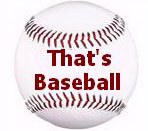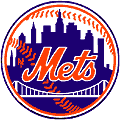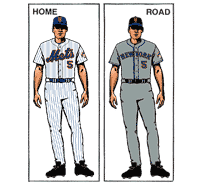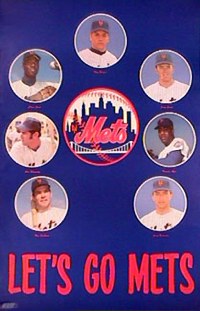 |
The
New York Mets
in the 1960s
Summary
|
 |
|||||||||
 |
[T]he Mets were created as a compromise solution to the Continental League's threatened incursion into the majors.... The franchise's first moves included adopting the blue (Dodgers) and orange (Giants) colors of its local predecessors .... [P]rincipal owner Joan Payson and club chairman M. Donald Grant [chose] ... George Weiss, the 66-year-old architect of the great Yankee teams of the late 1940s and 1950s, who had been forced into retirement in the Bronx [for general manager] .... The Yankees ... [saw] red when Weiss then went out to recruit such former Bronx names as Johnny Murphy, Gil McDougald, Whitey Herzog -- and, in particular, Casey Stengel. Nobody was surprised when the Yankees turned a cold shoulder to the notion of hosting the Mets at Yankee Stadium while a new ballpark was being built for the fledgling franchise.
Stengel, who had also been forcibly retired by the Yankees, signed on with the team as manager, but that turned out to be only one of his roles. Confronted with expansion players who were to constitute one of the worst teams in baseball history, Stengel...worked the press and television (and, through them, the fans) tirelessly to represent his charges as New York's biggest entertainment attraction. From February to October for almost four years, hardly a day went by without the sports pages reporting some bizarre (or bizarrely stated) observation from the Old Professor on the sorry state of his team. The public relations performance worked to endear the incompetent Mets to many of the same fans who, only a few years before, would have sulked if their Dodgers or Giants had failed to win the pennant....
Going for familiar names in the expansion draft and subsequent trades, the Mets filled their roster with aged stars like Gil Hodges, Richie Ashburn, Gus Bell, and Gene Woodling. Also found appealing were players with an Ebbets Field pedigree -- Hodges, Charlie Neal, Don Zimmer, Roger Craig, and Clem Labine. What it all added up to was a record-shattering [1962] season of 40 wins and 120 losses that included nine straight losses to open the season, an 11-game losing streak between August 9 and August 21, and a 17-game losing skein between May 21 and June 6....
Despite the concentration of ex-Dodgers like Hodges and declining stars like Ashburn, the New Breed ended up devoting most of its attention to other players -- perceived as more appropriate symbols for the various flaws in the human condition the Mets brought to mind. Among them were Rod Kanehl, who could play all the infield and outfield positions, but none of them well; Choo Choo Coleman, a catcher whose main skill was chasing down passed balls; Elio Chacon, a shortstop whose lack of English extended to "I've got it" and led him into almost daily collisions with oncharging outfielders; and Al Jackson, a pitcher of genuine talent who ... in the words of Stengel, had to be relieved on occasion before 'he committed suicide on the mound.' Most of all there was Marv Throneberry, a first baseman whose feats of missing popups, ground balls, and bases became the most enduring emblem of the early Mets.
The groaning laughter from the grandstands and the media failed to impress Weiss, accustomed to collecting pennants and World Series trophies from his days with the Yankees. Already irritated [that] the team had to play its first two years in the deteriorating cavern that was the Polo Grounds, he imported and exported dozens of players in the vain attempt to match the play of at least fellow-expansion Houston .... A dour man, Weiss was also slow to realize the promotional value of the sheets and placards carried to the Polo Grounds by fans bent on proclaiming their sentiments about the team; only after his confiscation policy was blasted in the press did he rescind the order and give impetus to the banners that were the become a cardinal feature of the ballpark.
In their first four seasons the Mets never lost fewer than 109 games and never ended a season closer to first place than 40 games. The "instant recognition" philosophy of players continued with the purchase of all-but-done stars like Duke Snider, Yogi Berra, and Warren Spahn. Another 1963 import was Jimmy Piersall, the Fear Strikes Out center fielder who marked his 100th home run by trotting around the bases backward and who was then quickly traded because, according to Stengel, there wasn't room for two clowns on the team. For those seeking signs of an eventual improvement in the play of the club, the main source of hope was second baseman Ron Hunt and first baseman Ed Kranepool. Hunt, whose specialty was getting hit by pitched balls, finished second only to Pete Rose in the voting for the 1963 Rookie of the Year; a year later, he became the first Met elected to a starting berth in the All-Star Game .... Although he never reached 60 RBIs and closed with a lifetime batting average of .261, Kranepool spent his entire 18-year career with the Mets.
The most immediate results of the team's move from the glum Polo Grounds to Shea Stadium in 1964 was a dramatic hike in attendance. After two seasons of barely missing and barely topping the one-million mark, the team reeled off annual attendance totals of 1.7, 1.7, 1.9, 1.5, and 1.7 million in its first five years in the new Queens facility.
What the fans mainly got for their money were memorable games that the Mets, for all their David-versus-Goliath valor, still ended up losing. In 1964, for instance, the team observed Memorial Day by battling the Giants in a record-breaking 10-hour doubleheader that featured a 24-inning nightcap during which the Mets pulled off a triple play, San Francisco's Willie Mays was forced to play shortstop, and Gaylord Perry pitched 10 shutout innings thanks to his first big league use of a spitball. Three weeks later, on Father's Day, 27 Mets trooped to the plate and then back to the bench again as Philadelphia's Jim Bunning tossed a perfect game against them.
The out-with-the-old-in-with-the-new attitude spurred by the team's shift to Shea Stadium came close to costing Stengel his position as manager for the 1965 season. After still another cellar finish, the press stepped up its quotes from the usual anonymous players accusing him of falling asleep on the bench during games and no longer even being able to identify his personnel .... Stengel's ties to the team were unraveled, then severed altogether, by two accidents during the 1965 season. In the first one, on May 10, the 74-year-old manager fractured his wrist in a fall at West Point, where the Mets had gone to play an exhibition game. The injury forced him to turn over the club, at least temporarily, to coach Wes Westrum. Then, in late July, during a banquet held to honor the former stars who would appear the following day at an old-timers' game, another fall fractured his hip ....[W]ith explicit blessings from Stengel and despite previous indications that [Yogi] Berra would be tapped as a successor, coach Wes Westrum was given a contract as the new manager. It was under Westrum in 1966 that the team avoided 100 losses for the first time and even got out of the cellar past the Cubs.
Because of the improved showing, 1967 was the first season in which the hopes of the New Breed did not appear completely unrealistic. They did, however, prove groundless when the team slipped back to last place with 101 losses. The responsibility for the reversal was equally shared among the players, the manager, the front office, and the ownership -- and with important ramifications for the team that was to excite the nation only a couple of years later.
On the field, the 1967 team's only effective offense came from the leg-sore Tommy Davis, who batted .302 with 16 homers and 73 RBIs after being obtained in a trade with the Dodgers for Hunt. On the bench, Westrum managed with a defensiveness that observers attributed to his fears he would be replaced any day by the far more popular Berra. Up in the general manager's office, [Bing] Devine, who had ... [replaced] Weiss before the start of the season, behaved as though his only priority was to put a personal imprint on the team; at one time or another during the season, 27 different pitchers and 27 different position players wore the Mets uniform ....
The first to crack was Westrum who, with less than two weeks to go in the season, asked for a contract renewal, got turned down, and resigned on the spot. Grant immediately ... [ordered] Devine to get the one and only man he wanted as the next manager -- the then-skipper of the Washington Senators, original Met [Gil] Hodges .... It fell to Devine's assistant, Johnny Murphy, to work out a deal with the Senators under which Hodges was released from his managerial contract with Washington in exchange for minor league pitcher Bill Denehy and $150,000 .... Murphy was tapped as Devine's successor as general manager.
Even before the start of the 1968 season, the tandem of Hodges and Murphy signalled a new Mets era. For one thing, Hodges politely but firmly insisted he would select his own coaches -- an ordinary option for the managers of most teams, but a privilege denied to both Stengel and Westrum .... Murphy underwrote the new manager's philosophy of maintaining as much personnel stability for the season as possible; in 1968, 20 fewer players wore the Mets uniform than had under Devine the previous year.
In raw numbers, the 1968 accomplishments of the Mets were modest. At the end of the season, they found themselves out of the cellar and 12 games better off than in 1967, but they were still 16 games below a break-even mark. On the plus side, however, was the near-emergence of a nucleus of young players who were to make the team competitive for years to come. These included catcher Jerry grote, shortstop Bud Harrelson, outfielder Cleon Jones, and pitchers Jerry Koosman (19 wins in 1968), Nolan Ryan, and Jim McAndrew. Most of all, there was the righthander who was to become known as The Franchise, Tom Seaver.
Seaver came to the Mets through the sheerest luck -- via a special lottery drawing held by the commissioner's office after his earlier signing by the Braves had been ruled as being in violation of the amateur drafting rules. As soon as the Mets were awarded first negotiation rights ... the team signed the Fresno native to a $50,000 bonus contract and installed him in the rotation as the number two starter behind Jack Fisher in May of 1967. Seaver responded with the most wins (16) ever by a Mets pitcher and surprised nobody by being voted NL Rookie of the Year. In 1968, he won another 16 games and struck out more than 200 batters for the first of nine consecutive seasons . It would not be until 1974 that his earned run average for a season would touch 3. Seaver became the franchise's first Hall of Famer ....
....On the eve of the 1969 season, the team's hitting problems appeared to have been resolved with a trade for Joe Torre, the Brooklyn-born catcher for the Braves who had been feuding with his own front office. But just when the deal appeared done, Atlanta suddenly upped its asking price, and talks broke off .... Finally, in May, the Mets got their man when they obtained power-hitting first baseman Donn Clendenon from Montreal in exchange for four minor league prospects.
Even with Clendenon's bat and Hodges' clear determination to make the clownish Mets of Stengel a thing of the remote past, there was little reason to think the club would mark its first year of divisional play by marching on to a World Series championship. Particularly debatable was Hodges' declared intention of maintaining a season-long platoon in right field and at all the infield positions except shortstop. As it turned out, almost all the platoon players had career or near-career years; the shortstop Harrelson emerged as one of the league's deftest fielders, catcher Grote shone as a defensive backstop at least the equal of Cincinnati's Johnny Bench, left fielder Jones batted .340, and center fielder Tommie Agee overcame a horrendous season in 1968 to lead the club offensively with 26 homers and 76 RBIs. But both on and off the mound, it was the pitchers -- and primarily Seaver -- who proved to be the key .... [T]he righthander [had] the first of his three Cy Young Award seasons, posting a 25-7 record and an ERA of 2.21.
The drive to the East Division title remained highly improbable as late as the second week of August, when the team was still behind the first-place Cubs by 9.5 games. By winning 38 of its next 49 games, however, the club ended up with its own eight-game lead over Chicago and built the legend of the Miracle Mets. Down the stretch, omen seekers were more than satisfied by one game against the Cubs in which a black cat strolled out of the stands at Shea Stadium and scampered over to vex Chicago manager Leo Durocher, and by another game in which St. Louis ace Steve Carlton struck out a record 19 batters -- but still lost to the mets on two home runs by right fielder Ron Swoboda. Another turning point, according to many of the Mets themselves, was a midseason game in which Hodges called time to take a long stroll out to left field and order Jones to accompany him back to the dugout for being less than energetic in his defensive play.
In their first taste of postseason competition, the Mets resorted to hitting rather than pitching to sweep the Braves in the League Championship Series. In the World Series against heavily favored Baltimore, they fell back on pitching, the timely slugging of Clendenon and second baseman Al Weis, and the spectacular outfield defense of Agee and Swoboda to win four out of five against the Orioles. New York was the first expansion team to take a world championship, and would continue to stand alone in that category until the Kansas City Royals defeated the Cardinals 16 years later.
-- Dewey & Acocella
Total Baseball
 oo oo |
||||||||||